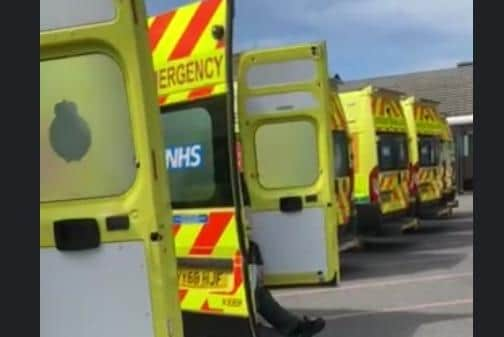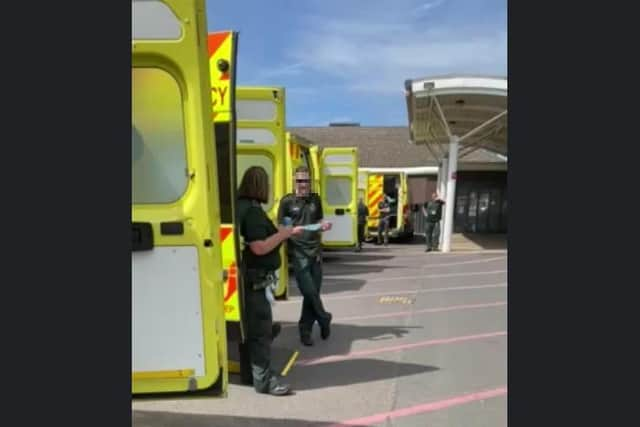Pictures reveal 'scandalous' ambulance queue at Northern General Hospital in Sheffield
and live on Freeview channel 276
Shocked pensioner Jeff Wood filmed the scene as crews were left to wait until they could drop off their patients, at around 3pm on Thursday, June 16.
Mr Wood was there with a friend from Nether Edge who had been taken to hospital by ambulance after collapsing and knocking himself out in the garden at his home in the city.
Advertisement
Hide AdAdvertisement
Hide Ad

Mr Wood said his friend waited around an hour and a half for an ambulance. He drove out from Barnsley to offer an alternative if the ambulance had still not arrived.
He said when his friend arrived at hospital at around 1pm there appeared to be four vehicles queuing outside. By the time he left his friend at 3.30pm, he estimated there were 20. His friend was taken into A&E at 4pm. Someone had earlier come out to briefly assess him. He then waited an hour on a ward, and two hours for a scan, before being admitted.
Mr Wood said: “The ambulance crews said it was typical. They said there were not enough staff and not enough space in the A&E to take everyone through. There is a trauma route if it is more serious, but my friend did not qualify. That was on a Thursday afternoon. What's it going to be like on Friday nights?
“It can’t go on like this. I know it’s not restricted to Sheffield, but something needs to be done.
Advertisement
Hide AdAdvertisement
Hide Ad

“I’m going to write to my MP because I think it’s a scandal. We’re degrading what was a great health service.”
He said he did not blame NHS workers, but felt the Government was responsible.
Michael Harper, chief operating officer, Sheffield Teaching Hospitals NHS Foundation Trust said: “The demand on our A&E remains very high and our teams are going above and beyond every day to see and treat patients as soon as possible.
"Currently on average 7 out of 10 patients are seen and have either started treatment, been discharged or a decision made to admit to a ward within 4 hours of arrival. We currently have more ambulances than usual coming to A&E and we are working closely with Yorkshire Ambulance Service to ensure the patients are transferred and ambulances are released as soon as possible.
"Once ambulance crews have handed over their patient, they then prepare the vehicles ready to respond to the next emergency and this can be seen on the video taken by the member of the public as well as the new ambulances bringing in patients. We will continue to manage the situation and ask people to be kind to our and the ambulance staff as they work hard to do this.”
Advertisement
Hide AdAdvertisement
Hide AdA Department of Health and Social Care spokesperson said: “We recognise the pressure NHS staff are under, especially those on the frontline in emergency care, and we continue to thank them for their dedicated hard work.
“The NHS has allocated £150 million of additional funding to address pressures on ambulance services, with the number of ambulance and support staff increasing by almost 40 per cent since February 2010. We have also established a national taskforce to identify ways to reduce delayed discharges and ensure patients are only in hospital for as long as they need to be.”

